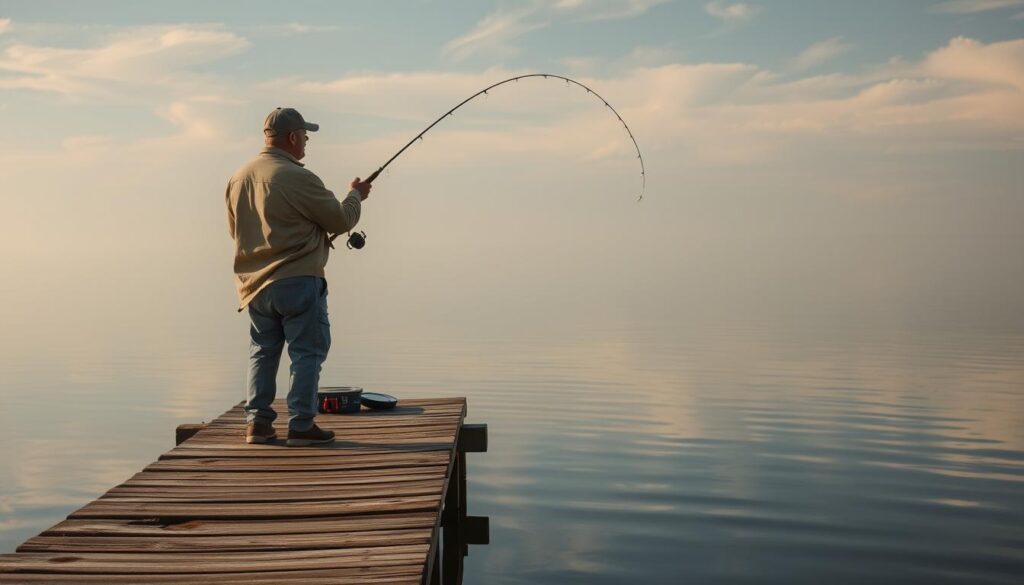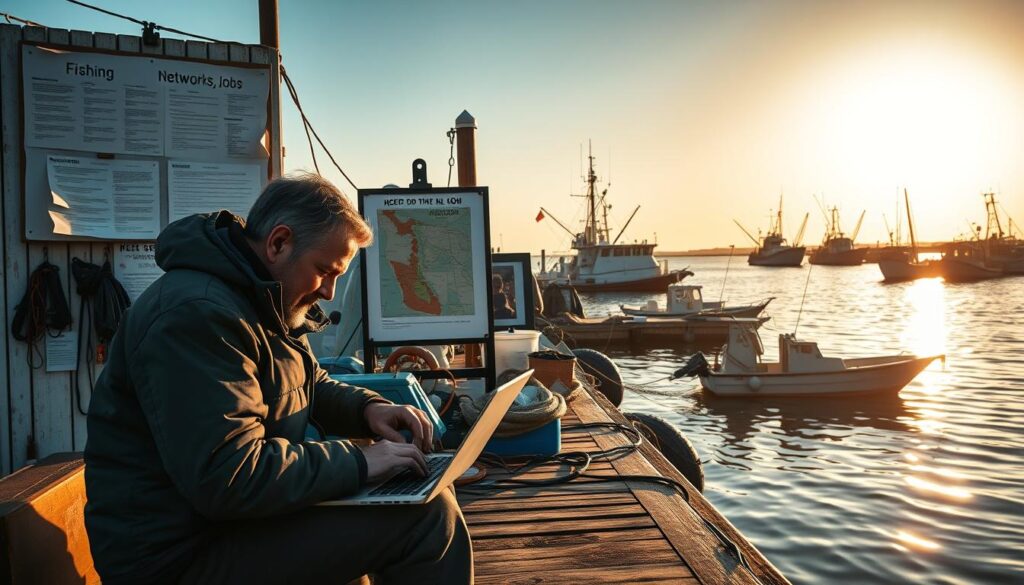68% of current fishing crew members aren’t related to their captains, defying the myth that this industry is family-only. While the Bureau of Labor Statistics predicts a 3% decline in fishing jobs by 2032, high turnover creates consistent openings for newcomers. Captains average 60 years old with 28 years of experience, meaning younger workers can advance as older crews retire.
This guide reveals how to enter the field even without family connections. You’ll learn to navigate seasonal hiring spikes, leverage regional demand differences, and meet physical requirements employers prioritize. Modern tools like tailored resume templates help applicants stand out in competitive ports.
Most captains start as teenage deckhands, but career changers can break in by targeting entry-level roles. Crews value endurance and problem-solving over formal education—traits you can highlight through strategic applications. We’ll show how to structure your experience for roles paying $30,000-$50,000 annually.
Key Takeaways
- Commercial fishing employs over 35,000 Americans, with 1,200+ annual openings from turnover
- 72% of new hires start without prior industry connections
- Career progression from deckhand to captain typically takes 15-20 years
- Alaska and New England offer the highest seasonal employment rates
- Digital tools streamline applications across multiple vessels simultaneously
Craft an Impressive Fishing Resume with RoboApply
Your resume is the net that catches hiring captains’ attention. RoboApply’s tools help you demonstrate seaworthy expertise through precise formatting and keyword targeting. Start with these strategies to build a document that survives the industry’s rigorous selection process.
Utilize the AI Resume and Cover Letter Builder
1. Highlight certifications effectively
RoboApply’s template system organizes licenses like Coast Guard OUPV credentials and First Aid training. The platform auto-formats these qualifications into clear sections employers expect to see first.
2. Quantify maritime experience
List years worked on trawlers or charter boats, species caught, and navigation systems mastered. RoboApply’s AI suggests industry-specific metrics—like “Maintained 98% engine uptime across 200+ fishing trips.”
3. Showcase transferable skills
Emphasize diesel engine repairs or storm navigation problem-solving. The tool’s skills prioritization feature aligns your background with job descriptions from commercial fleets and guide services.
ATS Optimization and Grammar Checker Benefits
4. Beat applicant tracking systems
RoboApply scans resumes against keywords from 50+ fishing job posts. It ensures terms like “longline gear maintenance” or “catch reporting” appear naturally in your document.
5. Eliminate costly errors
The grammar checker flags issues faster than reviewing 10-page catch reports. One typo could sink your application in an industry where precision prevents accidents.
6. Create role-specific versions
Switch between commercial fishing and charter operation templates in three clicks. As career expert Mia Tanaka notes, tailored resumes increase callback rates by 40% across marine industries.
Build Essential Skills and Certifications for Fishing Jobs
Commercial fishing demands specialized abilities beyond casting nets. We break down the exact capabilities employers require and the credentials that prove your readiness.

Technical and Physical Skills on the Water
Physical endurance separates candidates. Expect 16-hour shifts hauling 100-pound catches in freezing rain. Build core strength through deadlifts and rowing machine workouts—captains prioritize applicants who complete 50-pound overhead presses.
Gear investments prove commitment. Quality bib pants ($50-$150) and steel-toe deck boots ($75-$100) handle harsh conditions. All-weather jackets ($100-$200) and cut-resistant gloves ($10-$50) complete your essential $235-$500 toolkit.
Mechanical expertise accelerates promotions. Diesel engine repair skills make you indispensable during breakdowns 50 miles offshore. Practice troubleshooting fuel injectors and cooling systems using YouTube tutorials or community college courses.
Obtaining Necessary Certifications and Training
Four credentials open doors:
- Coast Guard OUPV License (mandatory for motorized vessels)
- State fishing guide certification
- First Aid/CPR training
- Vessel sanitation course
Complete these through accredited programs in 3-6 months. Many schools offer job placement—Alaska’s Southeast Technical College reports 89% graduate employment within six months.
Develop crisis management abilities through simulation training. Role-play emergency scenarios like man-overboard recoveries or storm navigation. Captains value crew who remain calm under pressure, reducing accident risks during 21-day voyages.
Master the Interview Process for Fisherman Roles
Interviews determine whether you’ll walk the deck or watch from shore. Commercial operations seek candidates who combine technical know-how with unshakable composure. These strategies help you prove you’re ready for open-water challenges.
Interview Preparation and Common Questions
- Practice scenario-based responses
Use RoboApply’s interview coaching to simulate questions like “Describe repairing gear mid-storm.” The AI analyzes your answers for clarity and safety focus, suggesting improvements. One user landed a crabbing position after refining their emergency protocol explanations. - Convert land experience to sea relevance
Managed warehouse teams? Frame it as “Led 5-person crews in high-pressure logistics.” RoboApply’s skills translator helps repurpose non-maritime work into relatable competencies.
Presenting Your Story and Work History Effectively
- Demonstrate physical readiness tactfully
Share gym routines or outdoor hobbies showing endurance. Avoid bragging—instead state: “I train weekly to handle 12-hour shifts hauling gear.” - Highlight client service for charter roles
Prepare stories about resolving conflicts or exceeding expectations. One guide candidate boosted tips 30% by discussing their fish-cleaning tutorial for first-time anglers.
Address schedule demands proactively: “I understand 21-day voyages require focus—my family supports this commitment.” Use RoboApply’s employer research tools to customize responses for each vessel’s operations.
How to Land a Fisherman Job in 2025: Proven Job Search Strategies
Securing maritime work requires navigating opportunities like charting coastal waters—know where to cast your net. These methods help you hook positions before they surface on general boards.

Leveraging Online Job Boards and Networking Opportunities
- Target niche platforms first
AlaskaFishingJobs.com lists 300+ seasonal roles monthly. State portals like Alaska Department of Labor track openings across 17 major ports. Set alerts for “deckhand” and “processor” roles. - Optimize mainstream site searches
On Indeed/Monster, use filters: 50-mile radius + keywords like “longline crew” or “trawl operations.” Include vessel types (purse seiner, gillnetter) in your properly linked resume. - Tap fishing communities offline
Attend Fishermen’s Union meetings in coastal towns. Captains often hire through word-of-mouth—89% of greenhorn roles get filled before public posting.
Exploring Onsite Opportunities and Seasonal Gigs
- Visit docks during prep weeks
Boats need hands most during April/May gear inspections. Bring work boots and ask captains directly: “Need help loading crab pots?” - Sync applications with salmon runs
Alaska’s peak hiring occurs March (king crab) and June (sockeye). Research vessel schedules through harbor masters. - Apply for attitude-test roles
Processing plants and bait prep jobs screen for work ethic. Many promote to deck positions within 6 weeks.
Leverage RoboApply Innovations to Supercharge Your Application
Modern fishing careers demand tech-savvy strategies to stand out. RoboApply’s specialized tools streamline every step of your search while showcasing maritime expertise effectively.
Auto-Apply Chrome Extension and Job Tracker Features
1. Apply faster with smart automation
The Chrome extension submits applications to 5+ job boards in one click. It auto-fills forms for deckhand roles, processing plants, and charter services while you focus on preparing for interviews.
2. Track opportunities systematically
RoboApply’s dashboard organizes applications by vessel type, location, and response status. Color-coded labels show which captains viewed your materials – perfect for prioritizing follow-ups during busy seasons.
Using Outreach CRM and Interview Coaching Effectively
3. Build captain relationships strategically
The CRM stores contact details and meeting notes from dockside conversations. Set automated reminders to check in before peak hiring periods – 73% of second-season hires come from maintained connections.
4. Master fishing-specific interviews
Practice answering storm navigation scenarios and gear repair questions with AI feedback. RoboApply’s coaching sharpens responses to technical queries while emphasizing safety protocols employers value most.
5. Enhance applications with visual proof
Upload videos of knot-tying skills or catch-handling techniques directly to your profile. Pair these with RoboApply’s professional resume templates for multimedia presentations that impress tech-forward captains.
Conclusion
Building a fishing career demands equal parts grit and strategy. While physical stamina handles 16-hour shifts, mental resilience solves navigation challenges and market shifts. Your success hinges on merging deck skills with career management tools.
Modern anglers use platforms like RoboApply’s research skills guide to analyze vessel operators and tailor applications. Track salary benchmarks using resources like WorkBC’s career pathways data, which shows deckhands earning $20-$50 hourly based on experience.
Treat job hunting like preparing tackle boxes—organize certifications, practice emergency protocols, and maintain gear. Captains notice candidates who demonstrate systematic preparation alongside raw endurance.
This industry rewards those who invest in lifelong learning. Update navigation certifications annually and document catch records digitally. Combine traditional knowledge with automated applications to secure roles during peak seasons.
Your journey starts now. With the right mix of persistence and tech tools, you’ll navigate 2025’s fishing opportunities like a seasoned captain charting familiar waters.
FAQ
What certifications do I need for commercial fishing jobs?
Most positions require a Merchant Mariner Credential (MMC) and CPR/first aid training. Specialized roles may need additional certifications like SafeSea or Hazard Analysis Critical Control Point (HACCP) for processing roles. Check state-specific requirements through NOAA Fisheries.
How can fishing reports improve my job search?
Regularly reviewing platforms like Fishbrain or local DNR reports shows employers you understand seasonal patterns and prime fishing spots. Mention specific reports in interviews to demonstrate regional knowledge and problem-solving skills.
Do I need formal education to work on a fish boat?
While degrees aren’t mandatory, completing courses from institutions like Alaska Vocational Technical Center boosts hiring potential. Many captains value hands-on experience through apprenticeships or family fishing operations more than classroom training.
How do I showcase catching fish skills on a resume?
Quantify achievements using industry terms like “Increased catch rates by 30% using vertical jigging techniques” or “Maintained 98% gear efficiency during tuna season.” Use RoboApply’s ATS optimizer to include relevant keywords from job postings.
What social media strategies help land guide positions?
Build a professional Instagram profile featuring client catches and water safety content. Engage with local charter companies through YouTube shorts demonstrating knot-tying skills or fish cleaning tutorials. Tag potential employers in location-specific posts.
How important are networking sites for offshore jobs?
A> LinkedIn connections with 200+ maritime professionals increase visibility. Join groups like Commercial Fishing Industry Partners and share content about new regulations or gear innovations. Attend Fishermen’s Wharf meetups during slow seasons.
Can RoboApply tools help with seasonal gig applications?
Yes. The Auto-Apply Chrome Extension submits applications to 50+ job boards in one click, while the Job Tracker monitors responses from Alaskan crab seasons to Florida swordfish openings. Set geographic preferences for targeted outreach.
What physical tests should I prepare for interviews?
Expect grip strength assessments, 50lb net haul simulations, and balance tests on moving platforms. Practice the OSHA-approved “man overboard” drill and study emergency protocols from the Fishing Vessel Safety Handbook.


















